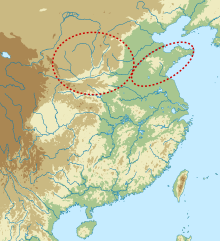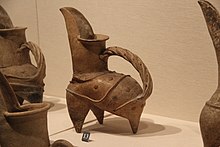
Back ثقافة لونغشان Arabic Луншань (культура) Byelorussian Cultura de Longshan Catalan Longshan-Kultur German Cultura de Longshan Spanish Longshanin kulttuuri Finnish Culture de Longshan French Lungsan-kultúra Hungarian Kebudayaan Longshan ID Cultura di Longshan Italian
 | |||||||||
| Geographical range | Lower and middle Yellow River, China | ||||||||
|---|---|---|---|---|---|---|---|---|---|
| Period | Neolithic China | ||||||||
| Dates | c. 3000 – c. 1900 BC | ||||||||
| Type site | Chengziya | ||||||||
| Major sites | Shimao, Taosi | ||||||||
| Preceded by | Yangshao culture, Dawenkou culture | ||||||||
| Followed by | Erlitou culture, Yueshi culture | ||||||||
| Chinese name | |||||||||
| Traditional Chinese | 龍山文化 | ||||||||
| Simplified Chinese | 龙山文化 | ||||||||
| |||||||||



The Longshan (or Lung-shan) culture, also sometimes referred to as the Black Pottery Culture, was a late Neolithic culture in the middle and lower Yellow River valley areas of northern China from about 3000 to 1900 BC. The first archaeological find of this culture took place at the Chengziya Archaeological Site in 1928, with the first excavations in 1930 and 1931. The culture is named after the nearby modern town of Longshan (lit. "Dragon Mountain") in Zhangqiu, Shandong. The culture was noted for its highly polished black pottery (or egg-shell pottery). The population expanded dramatically during the 3rd millennium BC, with many settlements having rammed earth walls. It decreased in most areas around 2000 BC until the central area evolved into the Bronze Age Erlitou culture. The Longshan culture has been linked to the early Sinitic (of the Sino-Tibetan languages).[1][2] According to the area and cultural type, the Longshan culture can be divided into two types: Shandong Longshan and Henan Longshan. Among them, Shandong Longshan Cultural Site includes Chengziya Site; Henan Longshan Cultural Site includes Dengfeng Wangchenggang Site in Wangwan, Taosi Site and Mengzhuang Site in Hougang.
- ^ Wen, Shao-Qing; Tong, Xin-Zhu; Li, Hui (2016-12-28). "Y-chromosome-based genetic pattern in East Asia affected by Neolithic transition". Quaternary International. Domestication East Asia. 426: 50–55. Bibcode:2016QuInt.426...50W. doi:10.1016/j.quaint.2016.03.027. ISSN 1040-6182.
- ^ Wang, Mengge; Zou, Xing; Ye, Hui-Yuan; Wang, Z.; Liu, Y.; Liu, J.; Wang, Fei; Yao, Hongbing; Chen, P.; Tao, R.; Wang, Shouyu (2020). "Peopling of Tibet Plateau and multiple waves of admixture of Tibetans inferred from both modern and ancient genome-wide data". bioRxiv. doi:10.1101/2020.07.03.185884. S2CID 220366671.